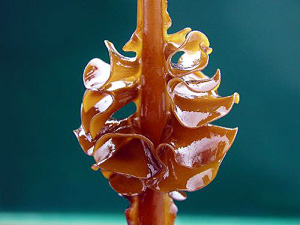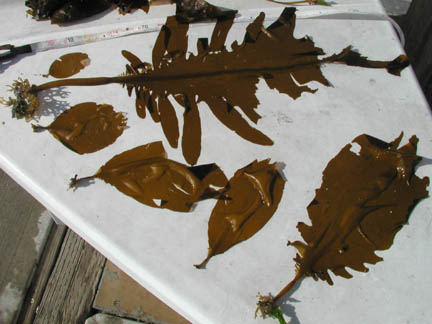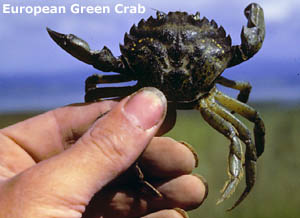 An “invasive species” is defined as one that is 1) non-native (or alien) to the ecosystem under consideration and 2) whose introduction causes or is likely to cause economic or environmental harm or harm to human health.
An “invasive species” is defined as one that is 1) non-native (or alien) to the ecosystem under consideration and 2) whose introduction causes or is likely to cause economic or environmental harm or harm to human health. This definition is often referred to in legal documents; however, in the scientific literature many terms are used, each of which has a slightly different connotation and meaning, depending on the context. Some of these terms include: introduced, foreign, exotic, alien, non-native, nonindigenous, immigrant, transplant, and naturalized. Whatever the term, they represent the addition of a new species to a natural system from which it has been historically absent.
Nonindigenous species may threaten the diversity or abundance of native species, alter the natural functioning of ecosystems, disrupt species interactions, and negatively impact commercial and recreational activities that rely on native marine resources. In addition to their ecological and economic impacts, some species represent significant human health hazards and diminish the social and aesthetic value of our natural resources.
Methods of Introduction
In many cases, these species were moved intentionally. For example, some plants have been used by public works agencies to stabilize soils and enhance public areas. State agencies have also added numerous fish species to lakes and streams throughout the United States to bolster commercial and recreational fishing interests. And while the benefits and potential impacts of these intentional introductions are often thoroughly discussed and reviewed by scientists, there are several examples in which unforeseen outcomes make such decisions seem uninformed in hindsight.
More recently researchers have investigated the causes and consequences of accidental introductions, especially in marine ecosystems. For example, the role of ballast water exchange became a hot research topic in the early 1990s.
Once a large ship has unloaded its cargo, the ballast tanks are filled with water to provide balance and trim for safe transit to the next port of call. Along with the ballast water, thousands of organisms are pumped into the tank, where they reside until the ballast water is offloaded. In many cases these organisms survive the journey, and as new cargo is loaded, these organisms are dumped into a new environment, which could be in another part of the state or in another country.
San Francisco Bay
San Francisco Bay, considered the most invaded aquatic ecosystem in North America, has at least 212 introduced species, consisting mostly of invertebrates such as clams and crabs. An additional 123 species are cryptogenic (not clearly native or introduced), which could drive the number of introduced species even higher.
Over the past 150 years, an average of one new species became established in the bay every thirty-six weeks. Since 1970 the rate has increased to one new species every twenty-four weeks, and this shows no sign of decreasing.
Monitoring
A recent study prepared by the California Department of Fish and Game and submitted to the California State Legislature (December 2002) found 360 introduced species in state waters. The study focused on seven major harbors and ports (e.g., San Francisco Bay; Los Angeles and Long Beach Harbors), but also included minor ports, bays, and estuaries.
In Monterey Harbor, 72 organisms were collected from the fouling community in the study. Of these, 12 were nonindigenous, 25 native, 9 cryptogenic, and 26 could not be identified to the species level.
Profiles
Below are profiles on two of the invasive species found in the Monterey Bay National Marine Sanctuary.
Undaria pinnatifida

One species that is readily recognized as an invader is the seaweed Undaria pinnatifida. Native to Asia and commonly known as wakame, Undaria was first detected in southern California in spring 2000. An annual species in its native range, Undaria in California first appears in the winter and becomes reproductive starting in February. In contrast, native annuals first appear in the spring and become reproductive in the summer. It is unclear how Undaria will impact native species, but in other parts of the world it is seasonally very dense and may displace native species.
In August 2001, Undaria was first noted in Monterey Harbor. In September 2002, Sanctuary staff and the Harbor Masters office coordinated with the City of Monterey’s Volunteer Program to survey and remove Undaria by hand from the floating docks. This is an on-going effort, and we hope to know soon whether these efforts have had any impact on the density of Undaria in the harbor or their rate of spread.
More information on Undaria:
- http://www.sanctuarysimon.org/projects/project_info.php?projectID=100184
- http://www.jncc.gov.uk/default.aspx?page=1676
European green crab (Carcinus maenas)
 First seen in San Francisco Bay in 1989, the green crab moved southward to Monterey Bay and northward to Humboldt Bay in California, Coos Bay in Oregon and into many Oregon estuaries. Green crab were sighted in Willapa Bay and Grays Harbor, Washington, and on the west coast of Vancouver Island, in 1998 and 1999.
First seen in San Francisco Bay in 1989, the green crab moved southward to Monterey Bay and northward to Humboldt Bay in California, Coos Bay in Oregon and into many Oregon estuaries. Green crab were sighted in Willapa Bay and Grays Harbor, Washington, and on the west coast of Vancouver Island, in 1998 and 1999.
The green crab feeds on many organisms, including clams, oysters, mussels, marine worms, and small crustaceans. Since it can also prey on juvenile crabs and shellfish, the invasion of this crab can put clam and oyster fisheries at risk, and the green crab may compete with native fish and bird species for food. In Bodega Bay, California, a significant reduction in population abundance of clam and native shore crab is already evident since the arrival of the green crab in 1993. In addition, the green crab is an intermediate host to a marine worm that can harm the health of local shore birds.
More information on green crabs: